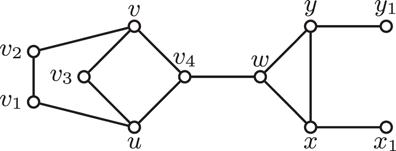Best possible upper bounds on the restrained domination number of cubic graphs
IF 1
3区 数学
Q2 MATHEMATICS
引用次数: 0
Abstract
A dominating set in a graph is a set of vertices such that every vertex in is adjacent to a vertex in . A restrained dominating set of is a dominating set with the additional restraint that the graph obtained by removing all vertices in is isolate-free. The domination number and the restrained domination number are the minimum cardinalities of a dominating set and restrained dominating set, respectively, of . Let be a cubic graph of order . A classical result of Reed states that , and this bound is best possible. To determine the best possible upper bound on the restrained domination number of is more challenging, and we prove that .

立方图的约束支配数的最佳上限
图中的支配集是这样一个顶点集合:图中的每个顶点都与图中的一个顶点相邻。限制支配集是一个支配集,其附加限制条件是移除所有 in 中的顶点后得到的图是无孤立的。支配数和受约束支配数分别是支配集和受约束支配集的最小心数。 假设是一个阶为 的立方图。里德的一个经典结果表明, ,而这个界限是可能的最佳界限。要确定......的受约束支配数的最佳可能上限则更具挑战性,我们将证明......。
本文章由计算机程序翻译,如有差异,请以英文原文为准。
求助全文
约1分钟内获得全文
求助全文
来源期刊

Journal of Graph Theory
数学-数学
CiteScore
1.60
自引率
22.20%
发文量
130
审稿时长
6-12 weeks
期刊介绍:
The Journal of Graph Theory is devoted to a variety of topics in graph theory, such as structural results about graphs, graph algorithms with theoretical emphasis, and discrete optimization on graphs. The scope of the journal also includes related areas in combinatorics and the interaction of graph theory with other mathematical sciences.
A subscription to the Journal of Graph Theory includes a subscription to the Journal of Combinatorial Designs .
 求助内容:
求助内容: 应助结果提醒方式:
应助结果提醒方式:


